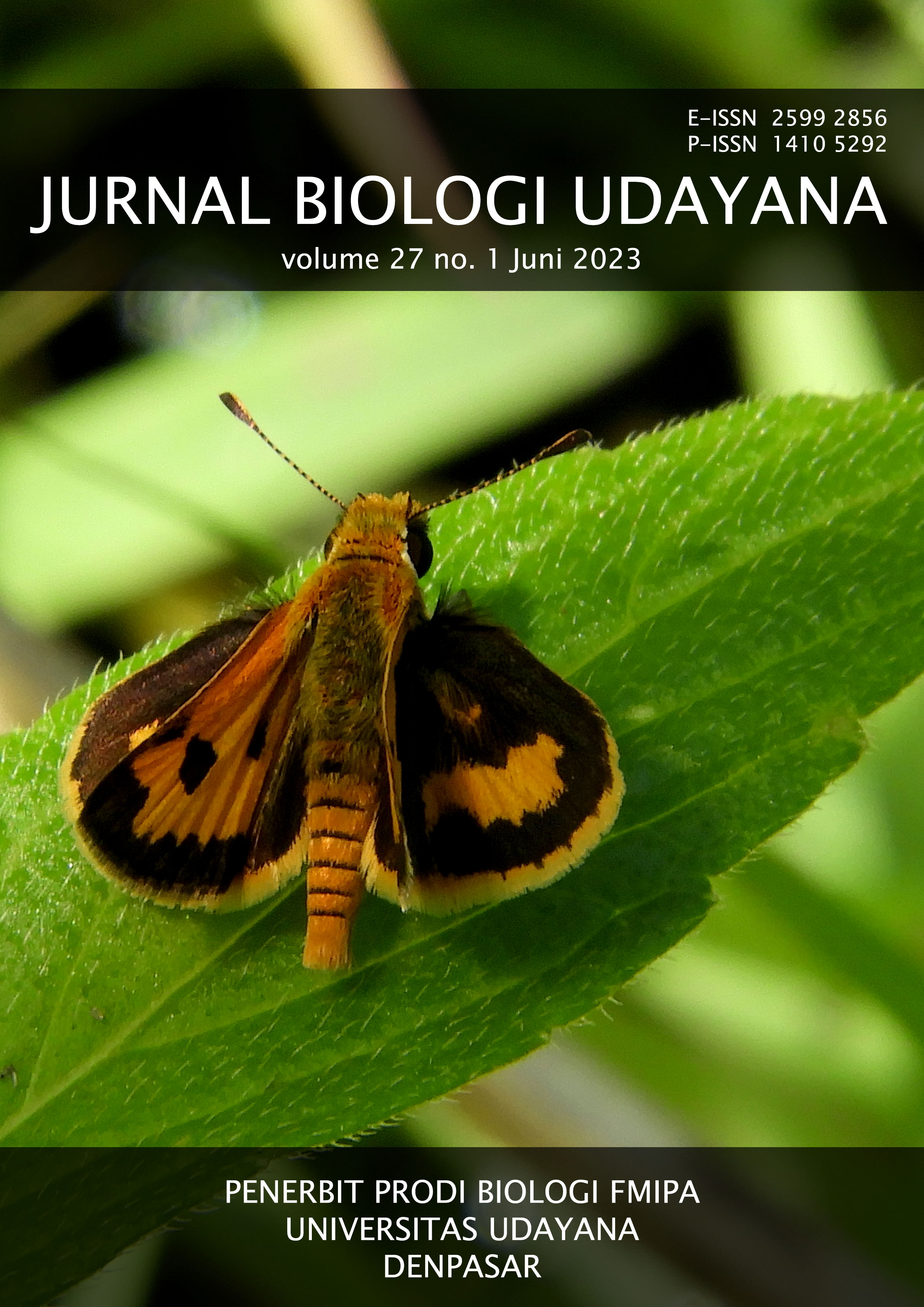Kajian Kajian anatomi, histokimia, dan karakteristik epidermal daun sawo kecik (Manilkara kauki (L.) Dubard - Sapotaceae)
Abstract
Manilkara kauki (L.) Dubard (sawo kecik) merupakan salah satu jenis pohon penghasil buah dari genus Manilkara Adans. (Sapotaceae). Jenis ini termasuk jarang dijumpai di Sumatera, termasuk di Provinsi Riau. Tujuan dari kajian ini adalah untuk mengetahui struktur anatomi dan histokimia daun M. kauki serta karakteristik epidermalnya. Pembuatan preparat anatomi dan histokimia dilakukan dengan menggunakan preparat segar dari 3 bagian daun M. kauki yaitu tangkai daun, ibu tulang daun dan helai daun. Senyawa metabolit sekunder yang diuji pada kajian histokimia adalah alkaloid, flavonoid, tanin dan lipid. Pembuatan preparat epidermal dilakuan dengan metode replika. Pengamatan struktur anatomi, histokimia dan karakteristik epidermal daun diamati dan didokumentasikan menggunakan mikroskop digital Olympus. Hasil kajian anatomi tangkai daun dan ibu tulang daun menunjukan karakteristik pada setiap jaringan, yaitu kutikula, epidermis, berkas pengangkut utama yang tersusun dari sklereid, floem dan xilem, serta adanya artificial laticifier pada bagian tengah. Berkas pengangkut tambahan hanya dijumpai pada tangkai daun. Struktur anatomi helai daun menunjukan adanya sklereid dan sel tanin pada mesofil. Hasil kajian histokimia menunjukan hasil posisif pada setiap organ yang diuji, namun konsentrasi setiap senyawa pada jaringan yang diamati berbeda-beda. Tipe stomata pada M. kauki adalah hipostomatik. Hasil kajian ini memberikan infomasi tambahan pada struktur anatomi, histokimia dan epidermal dari genus Manilkara.
Downloads
References
Borsuk AM, Roddy AB, Rancourt GT, Brodersen Cr. 2022. 2022. Structural organization of the spongy mesophyll. New Phytologist 234(3): 946 – 960. DOI: https://doi.org/10.1111/nph.17971
Chung K, Wong TY, Wei C, Huang Y, Lin Y. 2020. Tannins and human Health: A review. Critical Reviews in Food Science and Nutrition 38(6): 421 – 464.
Gotoh E, Noriyuki S, Takeshi H, Tomonao M, Hirokazu T, Masamitsu W. 2018. Palisade cell shape affects the light-induced chloroplast movements and leaf photosynthesis. Scientific Reports 8. DOI: 10.1038/s41598-018-19896-9.
Gutiérrez-Grijalva E, Leticia L, Laura C, Cristina E, José H. 2020. Plant Alkaloids: Structures and Bioactive Properties. 10.1007/978-981-15-2361-8_5.
Javelle M, Vernoud V, Rogowsky PM, Ingram GC. 2011. Epidermis: the formation and functions of a fundamental plant tissueNew Phytologist 189: 17–39. DOI: 10.1111/j.1469-8137.2010.03514.x
Kim H. 2020. Lipid Metabolism in Plants. Plants 9 : 871. 10.3390/plants9070871.
Matsuura HN, Fett-Neto AG. 2015. Plant Alkaloids: Main Features, Toxicity, and Mechanisms of Action. In: Gopalakrishnakone P., Carlini C., Ligabue-Braun R. (eds) Plant Toxins. Toxinology. Springer, Dordrecht. https://doi.org/10.1007/978-94-007- 6728-7_2-1.
Mardhak S, Savsani JD, Pandya DJ. 2013. Comparative Pharmacognostical And Phytochemical Study Of Leaves Of Different Species Of Mimusops. IJPSR 4(3): 1074-1078.
Moura BIV, Araujo BPL, Sa RD, Randau KP. 2019. Pharmacobotanical study of Manilkara zapota (L.) P.Royen (Sapotaceae). Braz. J. Pharm. Sci. 55. DOI: http://dx.doi.org/10.1590/s2175-97902019000117227.
Moreno G, Cózar, A., Prieto P. 2022. Radiationless mechanism of UV deactivation by cuticle phenolics in plants. Nat Commun 13: 1786. DOI: https://doi.org/10.1038/s41467-022-29460-9
Morris H, Lenka P, Patrick C, Esther F, Mark G, Hugo M, Daniel M, Elisabeth W, Jingming Z, Kasia Z, Steven J. 2015. A global analysis of parenchyma tissue fractions in secondary xylem of seed plants. The New phytologist 209. DOI: 10.1111/nph.13737.
Okuda T, Ito H., 2011. Tannins of constant structure in medicinal and food plants—hydrolyzable tannins and polypenols related to tannins. Molecules (Basel, Switzerland) 16(3): 2191–2217.DOI: 10.3390/molecules16032191
Pizzi, A. 2019. Tannins: Prospectives and Actual Industrial Applications. Biomoleculs 344: 1–30. doi:10.3390/biom9080344.
Prasawang S, Srinual A. 2020. Comparative leaf and wood anatomical characteristics of Chrysophyllum (Sapotaceae) relate to taxonomy of the species in Thailand. Biodiversitas 21(4): 1578-1587. DOI: 10.13057/biodiv/d210439
Sangi M, Runtuwene MRJ, Simbala HEI, Makang VMA. 2008. Analisis Fitokimia Tumbuhan Obat Di Kabupaten Minahasa Utara. Chem. Prog, 1(1): 47-53. DOI:https://ejournal.unsrat.ac.id/index.ph p/chemprog/article/view/26.
Schneidera HM, Strocka CF, Hanlona MT, Vanheesb DJ, Perkinsa AC, Ajmeraa IB, Sidhua JS, Mooneyb SJ, Browna KM, Lynch JP. 2021. Multiseriate cortical sclerenchyma enhance root penetration in compacted soils. PNAS 118(6): 1 - 11. DOI: https://doi.org/10.1073/pnas.2012087118.
Sharma K, Kumar V, Kaur J, Tanwar B, Goyal A, Sharma R. 2021. Health effects, sources, utilization and safety of tannins: a critical review. Toxin Reviews 40(4): 432-444 | DOI: https://doi.org/10.1080/15569543.2019.1662813
Sofiyanti N, Isda MN, Fitmawati, Agesti ARA, Taufik I, Sari M, Pranata S. 2021. Phytochemical Contents of Underutilized Edible Plant from Riau Province, Ridan (Nephelium maingayi Hiern – Sapindaceae). Jurnal Biologi Tropis 21(2): 354 – 360.
Sofiyanti N, Wahyuni PI, Iriyani D. 2022. Stomatal Characteristics of 5 Citrus L. Species (Rutaceae) From Pekanbaru, Riau Province 22(1): 173 – 178. DOI: 10.29303/jbt.v22i1.3100
Stepinski D, Kwiatkowska M, Wojtczak A, Polit JT, Domínguez E, Heredia A, Popło´nska K. The Role of Cutinsomes in Plant Cuticle Formation. 259(8): 1778. DOI: 10.3390/cells9081778.
Sudrajat D, Megawati. 2010. Keragaman Morfologi Dan Respon Perlakuan Pra Perkecambahan Benih Dari Lima Populasi Sawo Kecik (Manilkara kauki (L.) Dubard). Jurnal Penelitian Hutan Tanaman 7: 67-76. DOI: 10.20886/jpht.2010.7.2.67-76.
Tamsir M N, Norhaizan ME, Nurul S. 2020. Manilkara zapota (L.) P. Royen: Potential Source of Natural Antioxidants. Malaysian Journal of Medicine and Health Sciences 16: 193-201,.
Tong Z, He W, Fan X, Guo A. 2022. Biological Function of plant Tannin and Its Application in animal Halth. Front. Vet. Sci. Sec. Animal Nutrition and Metabolism DOI: https://doi.org/10.3389/fvets.2021.803657
Trimanto, Dwiyanti D, Indriyani S. 2018. Morfologi, anatomi dan uji histokimia rimpang cucurma aeruginosa Roxbl cucurma Longa L dan cucurma heyneana Valenton dan Zijp. Berita Biologi 17(2): 123 – 132.
Weston AL, Mathesius U. 2013. Flavonoids: Their Structure, Biosynthesis and Role in the Rhizosphere, Including Allelopathy. Journal of Chemical Ecology 39: 283-287. DOI: 10.1007/s10886-013- 0248-5
Wulansari TYI, Agustiani EL, sunaryo, Tihurua EF, Widoyanti. 2020. Struktur Anatomi Daun Sebagai Bukti Dalam Pembatasan Takson Tumbuhan Berbunga: Studi Kasus 12 Suku Tumbuhan Berbunga Indonesia Buletin Kebun Raya 23(2): 146–16. DOI: https://doi.org/10.14203/bkr.v23i2.266 146| Scientific Article
Vogelmann T, Martin G. 2006. The functional significance of palisade tissue: penetration of directional versus diffuse light. Plant, Cell and Environment 16: 65 - 72. DOI: 10.1111/j.1365-3040.1993.tb00845.x.
Yeats T, Rose J. 2013. The Formation and Function of Plant Cuticles. Plant physiology 163. DOI: 10.1104/pp.113.222737.





